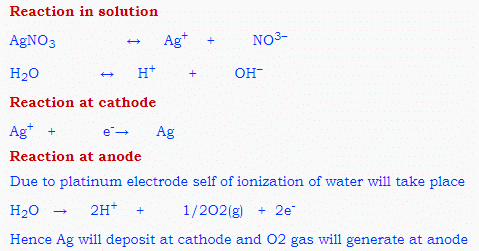NEET Exam > NEET Questions > Predict the product of electrolysis of. An aq...
Start Learning for Free
Predict the product of electrolysis of. An aqueous solution of AgNO3 with platinum electrodes.?
Verified Answer
Predict the product of electrolysis of. An aqueous solution of AgNO3 w...

 This question is part of UPSC exam. View all NEET courses
This question is part of UPSC exam. View all NEET courses
Most Upvoted Answer
Predict the product of electrolysis of. An aqueous solution of AgNO3 w...
Electrolysis of Aqueous AgNO3 Solution with Platinum Electrodes
Introduction
Electrolysis is a process that involves the decomposition of a compound by passing an electric current through it. In this case, we are considering the electrolysis of an aqueous solution of AgNO3 (silver nitrate) using platinum electrodes.
Electrode Reactions
During electrolysis, various reactions occur at the different electrodes involved. Let's examine the reactions at the anode and cathode separately:
Anode (Positive Electrode)
At the anode, oxidation occurs, leading to the release of electrons. In this case, nitrate ions (NO3-) are present in the solution, which can be oxidized. The possible reactions are:
1. 4NO3- (aq) → 2O2 (g) + 4NO2 (g) + 4e-
2. 2H2O (l) → O2 (g) + 4H+ (aq) + 4e-
From the above reactions, it is evident that oxygen gas (O2) will be formed at the anode. However, the actual reaction that takes place depends on the concentration of nitrate ions and the pH of the solution.
Cathode (Negative Electrode)
At the cathode, reduction occurs, resulting in the consumption of electrons. Silver ions (Ag+) are present in the aqueous solution, which can be reduced. The possible reaction is:
Ag+ (aq) + e- → Ag (s)
From this reaction, it is clear that silver metal (Ag) will be deposited at the cathode.
Overall Process and Prediction
Considering the reactions at both electrodes, the overall process of electrolysis of AgNO3 can be summarized as follows:
At the anode: Oxygen gas (O2) is evolved.
At the cathode: Silver metal (Ag) is deposited.
Therefore, the product of electrolysis of an aqueous solution of AgNO3 using platinum electrodes is oxygen gas (O2) at the anode and silver metal (Ag) at the cathode.
It is important to note that the concentration of AgNO3 and the current applied will affect the rate of the electrolysis process. Higher concentrations of AgNO3 and higher currents would result in a faster deposition of silver metal at the cathode.
Attention NEET Students!
To make sure you are not studying endlessly, EduRev has designed NEET study material, with Structured Courses, Videos, & Test Series. Plus get personalized analysis, doubt solving and improvement plans to achieve a great score in NEET.

|
Explore Courses for NEET exam
|

|
Similar NEET Doubts
Predict the product of electrolysis of. An aqueous solution of AgNO3 with platinum electrodes.?
Question Description
Predict the product of electrolysis of. An aqueous solution of AgNO3 with platinum electrodes.? for NEET 2024 is part of NEET preparation. The Question and answers have been prepared according to the NEET exam syllabus. Information about Predict the product of electrolysis of. An aqueous solution of AgNO3 with platinum electrodes.? covers all topics & solutions for NEET 2024 Exam. Find important definitions, questions, meanings, examples, exercises and tests below for Predict the product of electrolysis of. An aqueous solution of AgNO3 with platinum electrodes.?.
Predict the product of electrolysis of. An aqueous solution of AgNO3 with platinum electrodes.? for NEET 2024 is part of NEET preparation. The Question and answers have been prepared according to the NEET exam syllabus. Information about Predict the product of electrolysis of. An aqueous solution of AgNO3 with platinum electrodes.? covers all topics & solutions for NEET 2024 Exam. Find important definitions, questions, meanings, examples, exercises and tests below for Predict the product of electrolysis of. An aqueous solution of AgNO3 with platinum electrodes.?.
Solutions for Predict the product of electrolysis of. An aqueous solution of AgNO3 with platinum electrodes.? in English & in Hindi are available as part of our courses for NEET.
Download more important topics, notes, lectures and mock test series for NEET Exam by signing up for free.
Here you can find the meaning of Predict the product of electrolysis of. An aqueous solution of AgNO3 with platinum electrodes.? defined & explained in the simplest way possible. Besides giving the explanation of
Predict the product of electrolysis of. An aqueous solution of AgNO3 with platinum electrodes.?, a detailed solution for Predict the product of electrolysis of. An aqueous solution of AgNO3 with platinum electrodes.? has been provided alongside types of Predict the product of electrolysis of. An aqueous solution of AgNO3 with platinum electrodes.? theory, EduRev gives you an
ample number of questions to practice Predict the product of electrolysis of. An aqueous solution of AgNO3 with platinum electrodes.? tests, examples and also practice NEET tests.

|
Explore Courses for NEET exam
|

|
Suggested Free Tests
Signup for Free!
Signup to see your scores go up within 7 days! Learn & Practice with 1000+ FREE Notes, Videos & Tests.

























